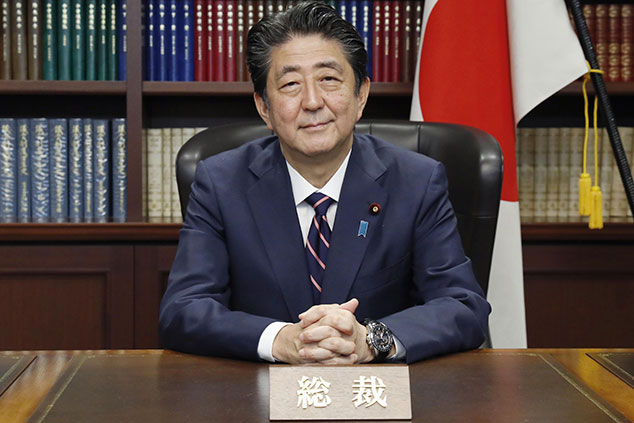
This article is taken from our FREE daily investment email Money Morning.
Every day, MoneyWeek’s executive editor John Stepek and guest contributors explain how current economic and political developments are affecting the markets and your wealth, and give you pointers on how you can profit.
In this week’s issue of MoneyWeek magazine
●
The Pacific Alliance: the four best bets in Latin America
●
Where to find Japan’s small, cash-rich bargain stocks
●
It’s too soon to sell out of tech stocks
●
A big trim for master-trust pension schemes
●
Three top-notch small European companies going cheap
● Share tips of the week
Not a subscriber? Sign up here
Elections are a nail-biting event for any incumbent leader these days, regardless of how secure their majority appears to be, or how predictable the result.
So Shinzo Abe, Japan’s prime minister, could have been forgiven for feeling a bit edgy ahead of his party’s leadership election last week.
He needn’t have worried; he won comfortably. That means Abe will be in charge now until at least 2021, which would make him Japan’s longest-serving prime minister.
And that’s good news for investors.
Abe’s reign has been good news for investors
When Abe first came (back) to power in 2012, he embarked on an ambitious set of reforms known as Abenomics. The central bank printed unprecedented sums of money and Abe made efforts (a bit later in the process) to free up the labour market, getting more women and older people into the workplace.
As Peter Tasker puts it in the Financial Times, “It worked”.
An incredibly low unemployment rate and a very high employment rate (ie, a very large proportion of those aged 15-74 are in jobs) means that wages are finally rising at a rate above inflation. Corporate profits are high, and investment is “booming” (because with wages rising, suddenly it makes a lot of sense for companies to spend money on automation).
As Tasker notes, you can’t necessarily pin all this on Abe’s work, but certainly the money printing and the psychological shift that it drove has helped a lot. So the continuity of that process is good news for investors.
What’s also interesting from an investment point of view is that Abe is now positioning Japan as the lead “green” economy in the world. In an opinion piece in yesterday’s FT, he said that world leaders needed to get together to sort out climate change, he noted: “Japan has goals such as creating ultra-high-capacity storage batteries, further decentralising and digitising automated energy control systems, and evolving into a hydrogen-based energy society.”
This is encouraging for two reasons. First, these are all exciting areas of investment right now. At some point, we’re going to see a proper bubble in “green” technology (we’ve seen small ones inflate across various individual sectors, but nothing that could be described as an epic bubble). If Japan is at the forefront of it, I want some of my money to be there too.
Secondly, it suggests that the Japanese government’s focus on evolving a more shareholder-friendly society will continue. Abe is more than happy enough to use the Japanese government pension fund (a massive investor) to put pressure on companies to improve their record on “environment, social and governance” issues, one of which is being more open to listening to shareholders.
One reason many Japanese stocks trade at a discount to their assets is because of this history of intransigence when it comes to unlocking value or treating shareholders like owners rather than inconvenient hangers-on.
Can Japan throw off the “iron coffin lid” for good?
Finally, timing-wise, this looks a good time to invest. Technical analysis is a topic which inspires a wide range of views. If you think it’s rubbish, feel free to ignore this point. But the Topic index – Japan’s equivalent of the S&P 500 (the Nikkei is more like the Dow) – has just risen above a particularly potent “line of resistance” once again.
Put simply, a line of resistance is a point at which a market has consistently struggled to rise above, mainly because there are a lot of sellers waiting to dump their holdings at that level. One particular level has kept the Topix index suppressed for many many years now.
Here’s a chart I prepared earlier (and if you’re interested in charting, you can read the accompanying piece here). You can see that the Topix has often bumped its head on the 1,800 level – what Jonathan Allum of SMBC Nikko describes as the “iron coffin lid”:
That chart runs up to late 2017. The Topix did manage to burst through, and by the start of 2018 had managed to claw its way above 1,900.
However, as you can see in the chart below, then the correction came. By the end of March, the Topix was back down below 1,700. However, it didn’t fall far. It made its way back above 1,800 in May again, then listlessly drifted back down below 1,700 by July.
But now the Topix has just pushed through “the iron coffin lid” again. It’s raced back above 1,800 in the last week or so.
What’s my point? It looks to me as though Japan is genuinely throwing off the last few decades and is finally ready to make a concerted push higher.
We’ve been recommending Japan for a long time and I suspect that many of you are already invested there. If you’re not, then I’d suggest you invest using one of the several high-quality London-listed investment trusts that focus on Japan. Merryn took a look at one very interesting looking new option in the most recent issue of MoneyWeek.